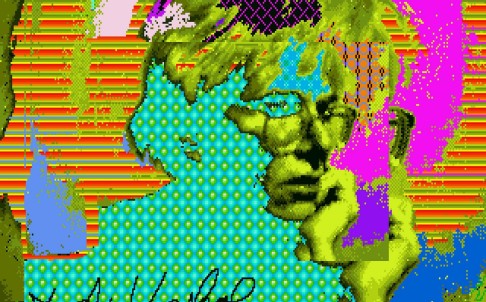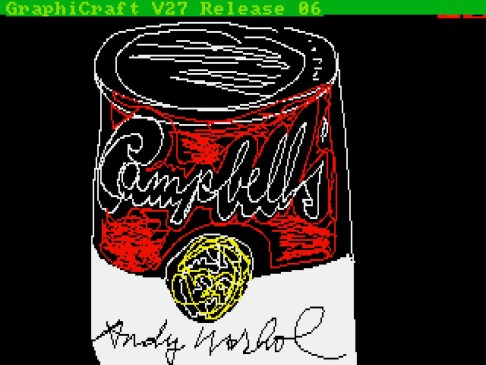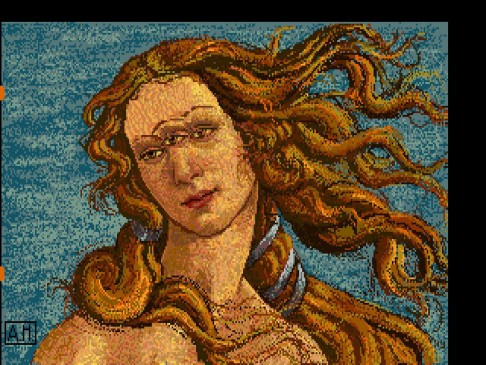Sleuths find digital images hiding in Andy Warhol’s old computer
Sleuths recover digital images apparently created by King of Pop Art nearly 30 years ago
PUBLISHED : Friday, 25 April, 2014, 8:53pm
UPDATED : Friday, 25 April, 2014, 8:53pm
McClatchy-Tribune in Pittsburgh, Pennsylvania

Images retrieved by forensic computer experts from Carnegie Mellon University from floppy disks in Andy Wahol's Amiga, the first advanced multimedia art graphics computer. Photos: Reuters
A group of university students and art sleuths have managed to recover lost digital images that were apparently created by Andy Warhol nearly 30 years ago and stored on floppy computer disks.
The Andy Warhol Museum, Carnegie Mellon University and the Carnegie Museum of Art - the three Pittsburgh institutions that all had a hand in the project - revealed the story this week in three news releases that included some of the images.

Those three images of an altered Botticelli's Venus, a Warhol self-portrait, and a Campbell's soup can - of 28 that were found on the disks - were enough to excite Warhol fanatics around the world over the possibility that something - anything - new by the King of Pop Art had been revealed.
They were created on Warhol's Commodore Amiga computer in 1985 and included versions of some of his other most iconic images such as a banana and Marilyn Monroe, neither of which have been released yet, and may never be.
While the historic and artistic value will take more research and debate to be figured out, Matt Wrbican, the Andy Warhol Museum's chief archivist, said the interest was understandable for one of the world's most prolific and studied artists.
"It's something that's new," he said, "and that doesn't happen very often with Warhol".
But Wrbican said even if Warhol had created the images by himself, "I want to emphasise we're not calling these art work. It was just Warhol learning a new tool".
The museum knew it had Warhol's Amiga computer and floppy disks, Wrbican said, and accessing it "was something I'd wanted to do for awhile, but there are only so many hours in a day".
It took a modern day, multi-media artist - and self-professed Warhol fanatic - to finally get the ball rolling.

New York-based artist Cory Arcangel was about to do a show at the Carnegie Museum of Art in August 2011 when his show curator, Tina Kukielski, asked him if he had any ideas for any Pittsburgh-focused work.
One of the ideas Arcangel proposed was based on a video he found on YouTube of Warhol "painting" rock artist Debbie Harry on an Amiga computer in 1985 on stage at Lincoln Centre in New York.
It was a slick advertising vehicle for Commodore to promote the Amiga, the first advanced multimedia art graphics computer. But it also put an Amiga in Warhol's hands.
"It was always unclear to me if [Warhol] had an Amiga and if he had any disks with work on them," Arcangel said. "So, when I came to Pittsburgh, Tina got me to together with Matt and he said, 'Well, yeah we do'."
Arcangel then called his friend and CMU associate professor Golan Levin to see if he knew anyone with any retro-computer expertise.
As it turns out, CMU had an energetic Computer Club interested in issues surrounding outdated computer technology - not only for the historic value of learning how computer technology evolved, but also as a way to confront future archiving issues.
"We were not optimistic when we first saw the floppy disks," said Keith Bare, a 2008 CMU masters graduate. "They were system disks, not personal copy disks with something handwritten on them like 'Andy Warhol's images'."
It turned out the disks, as well as the computer they were created on, were beta versions of both, which made accessing the systems that much more difficult. But using a self-created program, and a program called a KryoFlux to allow a modern computer to interface with a floppy disk, they managed to pull the images up and save them last year.
There remains some doubt about how much of Warhol is actually in the images. A man who worked with the now-defunct Amiga World magazine - which did a story in January 1986 about Warhol and his use of the Amiga computer - said he "doesn't think Warhol actually made a lot of those images".
"We'll discuss it with him," Wrbican said.
While it might be easy to think that new computer images by Warhol could quickly be turned into revenue for the museum, Wrbican said that even if Warhol did create them, it was not so easy to begin printing them.
Of the Marilyn Monroe image found on the computer, for example, he said, "we might not want to even release it because the people who control Monroe's image are very vigilant" and might sue the museum if it did.
Moreover, Wrbican said: "We don't really see them as Warhol's artwork, so I don't think we're going to be putting them out there on coffee cups to sell any time soon."
